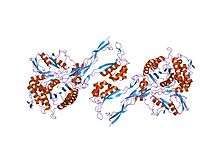PASTA domain
| PASTA domain | |||||||||
|---|---|---|---|---|---|---|---|---|---|
 Structure the PASTA domain in a penicillin binding protein. | |||||||||
| Identifiers | |||||||||
| Symbol | PASTA | ||||||||
| Pfam | PF03793 | ||||||||
| InterPro | IPR005543 | ||||||||
| SMART | PASTA | ||||||||
| PROSITE | PDOC51178 | ||||||||
| SCOP | 1rp5 | ||||||||
| SUPERFAMILY | 1rp5 | ||||||||
| CDD | cd06573 | ||||||||
| |||||||||
The PASTA domain is a small protein domain that can bind to beta-lactam rings found in antibiotics.[1] The domain was initially discovered in 2002 by Yeats and colleagues as a region of sequence similarity found in penicillin binding proteins and PknB-like kinases found in some bacteria. The name is an acronym derived from PBP and Serine/Threonine kinase Associated domain.
Structure
The PASTA domain adopts a structure composed of an alpha-helix followed by three beta strands. Recent structural studies show that the extracellular region of PknB that is composed of four PASTA domains shows a linear arrangement of the domains.[2]
Species distribution
PASTA domains are found in a variety of bacterial species including gram-positive firmicutes and actinobacteria.
References
- ↑ Yeats C, Finn RD, Bateman A (September 2002). "The PASTA domain: a beta-lactam-binding domain". Trends Biochem. Sci. 27 (9): 438. doi:10.1016/s0968-0004(02)02164-3. PMID 12217513.
- ↑ Barthe P, Mukamolova GV, Roumestand C, Cohen-Gonsaud M (May 2010). "The structure of PknB extracellular PASTA domain from mycobacterium tuberculosis suggests a ligand-dependent kinase activation". Structure. 18 (5): 606–15. doi:10.1016/j.str.2010.02.013. PMID 20462494.
This article is issued from Wikipedia - version of the 6/4/2016. The text is available under the Creative Commons Attribution/Share Alike but additional terms may apply for the media files.